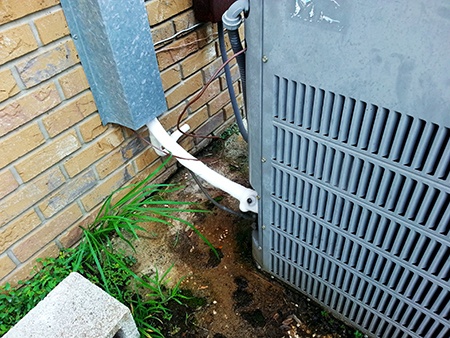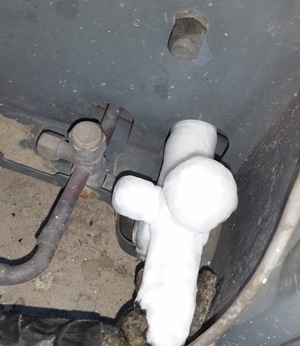We've noticed the article pertaining to What Causes AC Pipes To Freeze? below on the internet and thought it made good sense to write about it with you in this article.

Introduction
Discovering that your air conditioning pipeline is frozen can be concerning, particularly during hot summer season when you rely upon your a/c unit one of the most. Comprehending what to do in such a circumstance is vital to avoid additional damage to your cooling system and guarantee your convenience inside your home.
Recognizing the Causes
Numerous aspects can contribute to the cold of an air conditioner pipe. Understanding these reasons can assist you address the concern efficiently.
Absence of Airflow
One typical cause of an icy air conditioning pipeline is inadequate airflow. When the air movement over the evaporator coil is restricted, it can trigger the coil to go down below freezing temperature, causing ice formation on the pipe.
Reduced Refrigerant Levels
Insufficient refrigerant levels in your air conditioner system can also lead to a frozen pipe. Reduced cooling agent levels can cause the pressure in the system to go down, bring about the freezing of moisture on the evaporator coil.
Cold Weather Conditions
In chillier environments, freezing temperature levels outside can contribute to the freezing of air conditioning pipes. If your air conditioning system is not appropriately shielded or if there are leakages in the ductwork, chilly air can penetrate the system, creating the pipe to ice up.
Dirty Air Filters
Dirty or blocked air filters can restrict airflow in your AC system, bring about numerous problems, including a frozen pipeline. It's vital to replace or clean your air filterings system consistently to make sure proper air movement and avoid ice build-up.
Indications of a Frozen AC Pipe
Acknowledging the signs of a frozen air conditioner pipe is vital for prompt action.
Lowered Airflow
If you see a considerable reduction in air movement from your vents, it could suggest an icy pipeline.
Ice Buildup on the Pipe
Noticeable ice buildup on the refrigerant line or the evaporator coil is a clear indicator of a frozen a/c pipeline.
Weird Sounds from the Unit
Uncommon audios, such as hissing or bubbling, coming from your AC unit can signal that there's ice existing on the pipeline.
Immediate Actions to Take
When confronted with an icy a/c pipeline, it's vital to act swiftly to stop more damages to your air conditioning system.
Turning off the AC
The first step is to shut off your a/c to prevent the system from running and exacerbating the concern.
Checking for Blockages
Examine the location around the indoor device for any type of blockages that may be blocking air movement, such as furnishings or curtains.
Defrosting the Pipe
You can use mild techniques like placing towels soaked in warm water around the icy pipeline to assist thaw it gradually.
Safety nets
Taking safety nets can assist avoid future incidents of a frozen air conditioner pipeline.
When DIY Methods Fail
If your efforts to thaw the pipeline or address other problems are unsuccessful, it's time to call in a professional.
Importance of Hiring a Professional HVAC Technician
A certified HVAC technician has the competence and tools essential to detect and fix problems with your air conditioning system securely and efficiently.
Routine Maintenance Checks
Schedule routine maintenance contact an expert HVAC service technician to ensure that your air conditioner system is running efficiently.
Changing Air Filters
On a regular basis replace or cleanse your air filters to stop air flow limitations and maintain ideal efficiency.
Protecting Exposed Pipes
If your air conditioner pipes are revealed to cold temperatures, take into consideration shielding them to stop cold during winter months.
Looking For Professional Help
If DIY techniques fail to resolve the concern or if you're uncertain concerning just how to proceed, it's finest to seek aid from a certified HVAC specialist.
Conclusion
Taking care of an icy a/c pipe can be a discouraging experience, but recognizing just how to react can assist minimize damage and recover comfort to your home. By understanding the reasons, acknowledging the indications, and taking timely activity, you can properly deal with the issue and avoid future incidents.
G UP? HOW TO FIX IT?
It happens all over America. And the rest of the world probably. It’s the hottest day ever and for some darn reason your AC isn’t cooling the house. You fiddle with the thermostat to try and fix the problem. Nada. All you can do now is go outside and check the AC unit. You make your way there and find your air conditioner unit is frozen! But how?
In this post we’ll cover how you can tell that your air conditioner has frozen (other than the obvious reasons), what could have caused the freeze, and some of the things you can do about your AC freezing up. And if you have a frozen heat pump condenser, read our blog about it to learn what to do! But remember, it is always best to avoid your AC freezing up with an AC tune up. And if you are moving into a home, it's critical to get HVAC inspection so that you are aware of an AC problems before you move in.
Keep reading and you may be able to fix the frozen AC yourself. If you can’t, call an HVAC specialist. If you live in Maryland, call SuperTech HVAC for AC repair. We’ll take care of it.
How Does An Air Conditioning Unit Work?
How you probably imagine an AC works is wrong. Contrary to popular belief, an AC system does not inject cool air into a building. Instead, it removes the heat from inside and transfers it outside. Cool huh? (Pun intended).There are 4 major components among the 3 stations of an air conditioning system: the evaporator coil, the compressor, the condenser, and the refrigerant – a special chemical that links everything together through a closed loop system.
Station 1:
Warm indoor air is sucked into the return vent, through a filter, and blows over the evaporator coil. The heat is absorbed into the cold refrigerant, turning it from liquid to gas. The air, which is now cool, is blown back into the home to areas that your thermostat, i.e. you, has decided.
Station 2:
The refrigerant makes its way outside the house to the compressor, which squeezes the warm refrigerant, raising its gaseous temperature even more.
Station 3:
When the super hot vapor refrigerant reaches the condenser, the last step, the heat is expelled and absorbed into the outdoor air. The refrigerant instantly cools, which changes it from gas back to liquid form. The cold liquid refrigerant is now ready to return to station 1 and repeat the process.
Is Your AC Freezing Up? Here Are The Signs:
As you may have guessed, your air conditioner unit freezing up on a hot day is not normal.
If this happens, there's no need to panic. Often the issue can be solved with a little troubleshooting. If the AC unit is left frozen for too long however, you may find yourself with a bigger problem.
First things first, how do you know your AC is frozen?
Well, the obvious sign is the ice on your refrigerant line-set pipe. Simply check between your outdoor AC unit and your home's exterior wall to see whether your AC line frozen.
You might also have a frozen evaporator coil. This one's not as easy to check. You'll need to open a panel on the indoor unit to inspect. Don't do this unless you're handy. If you aren't, call an HVAC pro like SuperTech HVAC or you may damage something in the process.

Do you enjoy reading about How can I fix an air conditioner’s frozen pipe?? Write feedback further down. We would be delighted to hear your ideas about this content. In hopes that you come back again soon. Enjoyed reading our article? Please share it. Help other people discover it. Thank you for your time. Visit again soon.
Additional Information